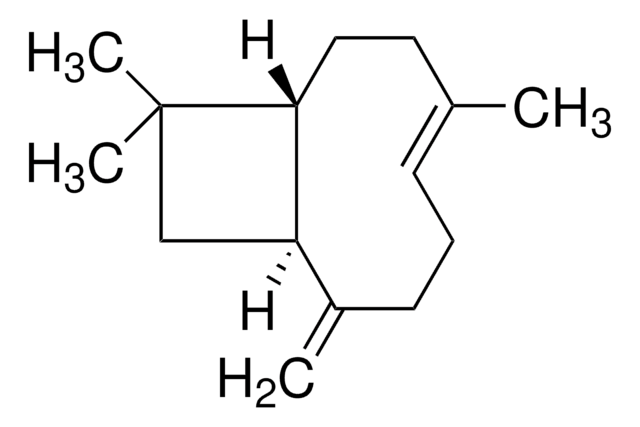Z3902
Zerumbone
≥98% (HPLC)
Sinónimos:
(2E,6E,10E)-2,6,9,9-tetramethylcycloundeca-2,6,10-trien-1-one, Zerumbone (6CI,7CI)
About This Item
Productos recomendados
assay
≥98% (HPLC)
form
powder
color
white to off-white
solubility
DMSO: ≥10 mg/mL
storage temp.
2-8°C
SMILES string
C\C1=C/CC(C)(C)\C=C\C(=O)\C(C)=C\CC1
InChI
1S/C15H22O/c1-12-6-5-7-13(2)14(16)9-11-15(3,4)10-8-12/h7-9,11H,5-6,10H2,1-4H3/b11-9+,12-8+,13-7+
InChI key
GIHNTRQPEMKFKO-SKTNYSRSSA-N
¿Está buscando productos similares? Visita Guía de comparación de productos
Categorías relacionadas
General description
Application
- for liquid chromatography with mass spectrometry (LC-MS-MS)
- to investigate its potential application in the prevention
- treatment of esophageal squamous cell carcinomas (ESCC)
Biochem/physiol Actions
signalword
Warning
hcodes
Hazard Classifications
Aquatic Acute 1 - Skin Sens. 1
Storage Class
11 - Combustible Solids
wgk_germany
WGK 3
flash_point_f
Not applicable
flash_point_c
Not applicable
Elija entre una de las versiones más recientes:
¿Ya tiene este producto?
Encuentre la documentación para los productos que ha comprado recientemente en la Biblioteca de documentos.
Los clientes también vieron
Contenido relacionado
n proliferating cells, the cell cycle consists of four phases. Gap 1 (G1) is the interval between mitosis and DNA replication that is characterized by cell growth. Replication of DNA occurs during the synthesis (S) phase, which is followed by a second gap phase (G2) during which growth and preparation for cell division occurs. Together, these three stages comprise the interphase phase of the cell cycle. Interphase is followed by the mitotic (M) phase.
Nuestro equipo de científicos tiene experiencia en todas las áreas de investigación: Ciencias de la vida, Ciencia de los materiales, Síntesis química, Cromatografía, Analítica y muchas otras.
Póngase en contacto con el Servicio técnico


![[6]-Gingerol ≥98% (HPLC)](/deepweb/assets/sigmaaldrich/product/structures/259/444/6877889c-1cc0-47f5-b807-f847deadec1d/640/6877889c-1cc0-47f5-b807-f847deadec1d.png)








